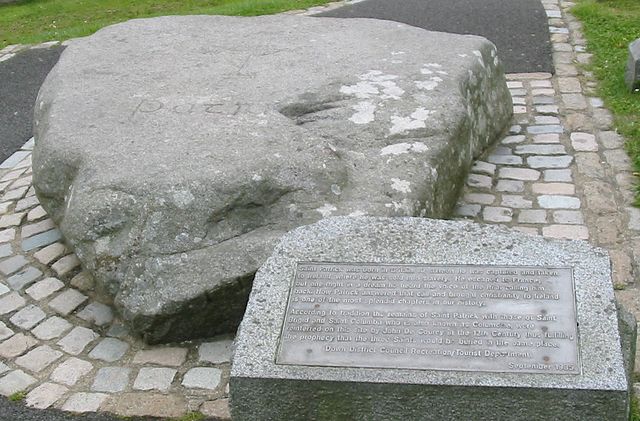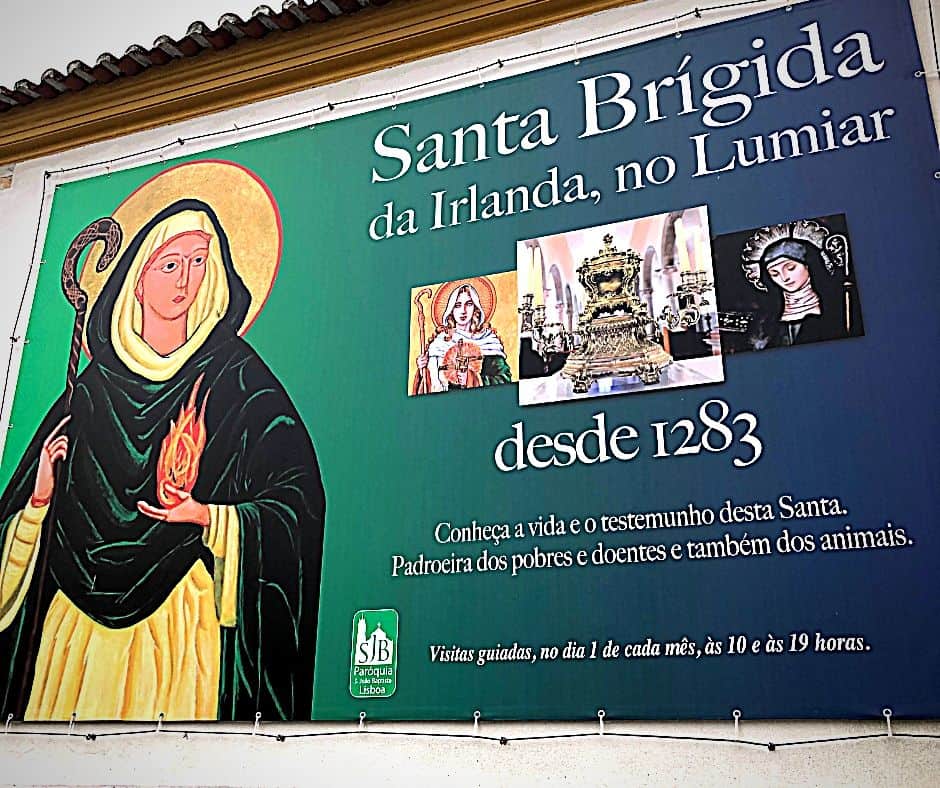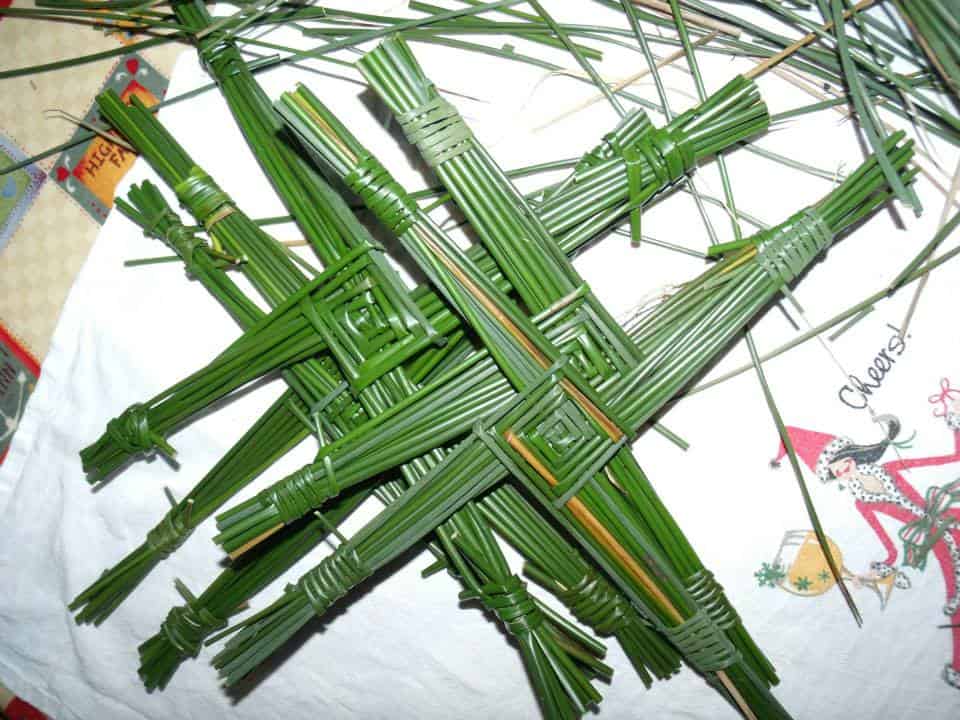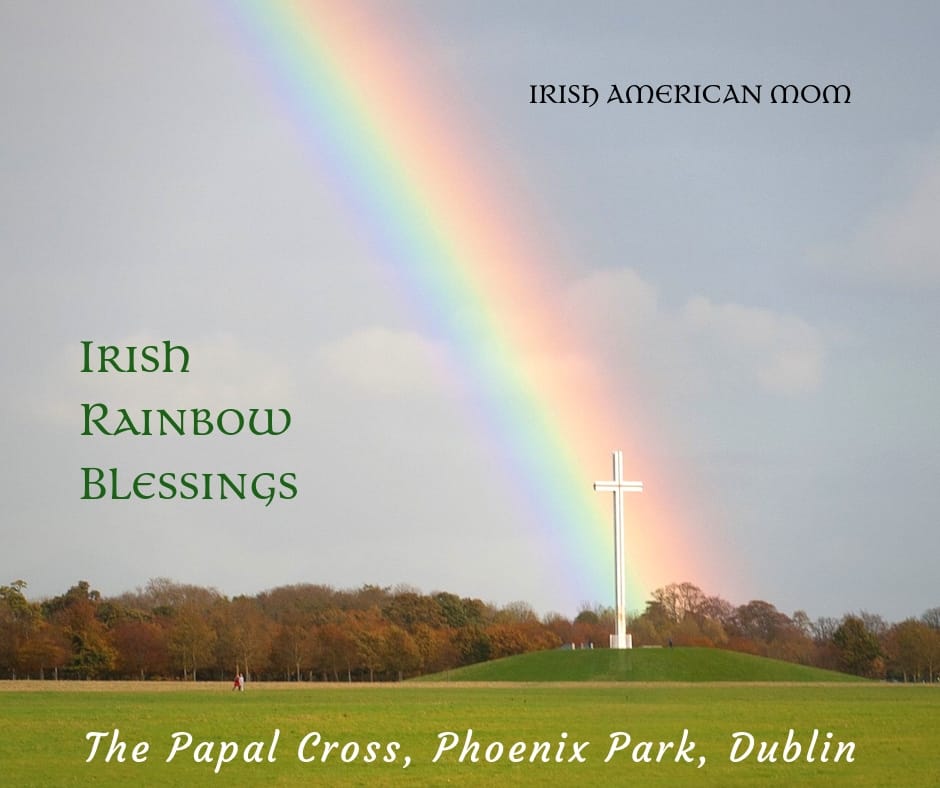Did you know that Saint Brigid of Ireland is highly regarded and revered in Portugal?
In the village of Lumiar, about six miles from Lisbon, and in the parish church of St. John the Baptist, is a chapel, dedicated to Ireland's beloved Saint Brigid. Here a relic of the saint, her actual skull, has been preserved and revered for centuries.
And so, on her feast day today, February 1st, let's explore the links between Saint Brigid and Lisbon, Portugal.

Table of Contents
Saint Brigid – Her Final Resting Place
St. Brigid of Kildare (c.452 - 525) died in the convent she had founded in Kildare in the eastern part of Ireland.
She, with the help of St. Conleth, whom she invited to join her, built a great religious center, including a convent, a monastery, plus a school of art and metal work.
After her death her remains were protected and venerated in an ornate altar in the monastery church along with the remains of St Conleth.
A monk named Cogitosus, writing an account of St Brigid’s life around the year 650 AD, described this altar as being “adorned with a refined profusion of gold, silver, gems and precious stones, with gold and silver chandeliers hanging from above and different images presenting a variety of carvings and colors”.

Tumultuous Times in Ireland
Her remains are said to have been moved to Downpatrick, Co Down in the year 835 AD for fear of the Danish Vikings, who were plundering Irish towns and monasteries.
Indeed, the following year the Danes attacked Kildare and stole the jeweled shrines of St Brigid and St Conleth.
Downpatrick was also at risk of Viking attack so St Brigid’s remains, along with those of Saint Patrick and Saint Colmcille were reburied in a place that was kept secret.
By 1185, when St. Malachy was bishop of Down, the site of the three saints’ burial place was unknown.In response to St. Malachy’s prayers a beam of light showed him the place on the floor of a church beneath which he found the saints’ graves.
Pope Urban the third, gave St Malachy permission to move the bodies to Down Cathedral, where they were interred on Jun 9th 1186 AD, on the Feast of St. Columcille.
Sadly, most of the relics of the saints were lost at the time of Henry VIII when he went on he indiscriminately dissolved monasteries all over the British Isles.
Saint Brigid - The Lisbon Link
Saint Brigid's skull was brought to Portugal by three Irish knights in the 13th century.
It's not known why or how these three Irish knights came to have the skull of St Brigid. And the question as to why they brought it with them on their way to the crusades in 1283 has never been answered.

Legend has it that they fought the Moors in Portugal and this is why her relic is now in the Church of St John, in Lumiar, in the suburbs of Lisbon.
The three faithful knights remained with the Holy Relic for the rest of their days, and when they died they were interred in tombs let into the wall of St. Brigid’s chapel.

An inscription on the outside wall of St John’s church, dated January 1283, tells us that the head of St Brigid rests in the chapel and that the knights are buried there. Here is the translation..
"Here in these three tombs lie interred the three Irish Knights (or gentlemen) who brought the head of the Blessed Saint Bridget, virgin, a native of Ireland, whose relic is in this chapel, for remembrance of which the officials of the board (or confraternity) of the saint, out of their own funds, caused this to be made A.D. 1283."
Today, many Irish pilgrims to Our Lady’s Shrine in Fatima include a visit to venerate St Brigid at St John’s Church in Lumiar, Lisbon on their way home to Ireland.

Saint Brigid's Relic Returned to Dublin from Portugal
In 1929 a small portion of St. Brigid’s skull was given back to the people of Ireland by the Cardinal of Lisbon and placed in St Brigid’s Church in Killester, Dublin with the approval of the Archbishop of Dublin and the solemn ceremony of translation occurred on Sunday 27th November 1929.
This is the church where my parents were married and I only recently learned that a relic from our beloved saint rests there.
Brigid, Saint of Earth and Farming
Saint Brigid of Kildare is a patroness of Ireland and also of those who have a care for the earth, for justice and equality, for peace and reconciliation.
In Portugal, on February 1st, she is called upon to bless all farming produce and livestock.
She is said to be the patron saint of cattle and many traditions link her to farming. One legend says that as a baby she was fed by the milk of a white cow with red ears. Other legends say she traveled around the countryside blessing farms, accompanied by her favorite white cow with red ears.

In some parts of Ireland homemade cake or bread and fresh butter are left on a windowsill outside with corn for the cow on her feast day in case she might pass by or as a gift to poor people, honoring St Brigid’s hospitality and charity.
In other areas a piece of cloth or a ribbon was left on the windowsill, near the house door or tied on the door knob to be touched by St Brigid and provide protection for people and animals from illness and pain.

St Brigid’s crosses would be used to bless cows that were ill or increase milk yield. Water from a well dedicated to Brigid would be sprinkled water on fields, livestock and homes.
How To Say Happy Saint Brigid's Day In The Irish Language
How wonderful that the tradition of St Brigid as patroness of farming has survived the centuries in Portugal too, where around Lisbon, on her feast day, cattle, crops and vines are blessed.
Beannachtaí na Féile Bríde oraibh go léir!
which translates into English as...
The Blessings of Saint Brigid's Day Be With You.
Here's a sound file to help with pronunciation.
Plus a phonetic guide for pronounciation.
Ban-uck-thee na fay-la Bree-da ur-iv guh lay-ur
Thanks for stopping by to learn about Saint Brigid of Ireland. You can celebrate St Brigid's Day on February 1st in the old Irish tradition, a day also known as Imbolc.

Slán agus beannacht,
(Goodbye and blessings)
Mairéad -Irish American Mom
Pronunciation - slawn ah-gus ban-ock-th
Mairéad - rhymes with parade
Here are some other posts you might enjoy...





Marjorie
This was new information for me about Saint Briigid. Thanks so much for sharing.
Irish American Mom
Hi Marjorie - I'm so glad I was able to share something new about Saint Brigid with you today, on her Feast Day. Thanks for stopping by to check out this post.
All the best,
Mairéad
Anne
Mairead, this is absolutely fascinating!!
I grew up across the road from St Brigid’s Church in Killester, (and I was baptized and got married there), but no one ever told me about the relic of St Brigid. Thank you for the information!
Irish American Mom
I did not know about it either until recently. My mom and sister went on a pilgrimage to Fatima and they visited the church in Portugal on the way back from Fatima to Lisbon. Here's a link about it...
http://www.killester.dublindiocese.ie/relic.htm
Thanks so much for stopping by to check out this post.
All the best,
Mairéad
Joan
Such interesting things about St.Brigid. Thank You
Joan
Irish American Mom
Hi Joan - Thanks for checking out this post about St. Brigid. It's nice to be able to share something a little different this year on St. Brigid's Day.
Best wishes,
Mairéad
Marion
I love this post on ST.Brigid. We have ST.Brigid cross on the porch and in the kitchen.
Marion
Irish American Mom
Hi Marion - I too have a St. Brigid's Cross in my home. It's a lovely Irish traditions.
All the best,
Mairéad
Marilyn`
Thank You for this informative and interesting post on St. Brigid. There are so many things I was not aware of concerning St. Brigid.
Marilyn
Irish American Mom
Hi Marilyn - I only learned of this story last year. I had no idea there is a relic of St. Brigid in Portugal until after my sister and mother visited the church near Lisbon after their pilgrimage to Fatima. It is such an interesting tale. It makes me wonder why would Irish knights take the skull of a saint on their quest to join the Crusades???
Take care,
Mairéad
Jeff
Mairéad,
Thank you for an extremely interesting story about St. Brigid!
Irish American Mom
Hi Jeff - This definitely is a tale less told than others. I too found it very interesting. Thanks for checking it out.
Take care,
Mairéad
Comdt Brendan M. Rohan. KCTJ
I have the honour to be an Irish Knight Templar of the Modern Rule and I was given to understand that in the 13th century, King Denis of Portugal wanted an authentic, saint’s relic, for the new, feminine Cistercian monastery he was founding at Odivelas near Lisbon, which would be his own final resting place.
Having petitioned Pope Urban, it was decided that St Bridget’s skull would be sent from where her bones rested beside those of St Patrick, in Downpatrick, Co. Armagh and as Jamesie enthused, three Irish, Templar Knights were assigned to escort the sacred relic to Odivelas in 1283. However, when they arrived there, to their horror the skull was missing. “A tale of three drunken k/nights” I hear you chime in but no, the reality is better than that old ditty.
The three Knights retraced their journey immediately and found the skull at the Church of St John the Baptist, at Lumier, about 3km away. Relieved, they brought it on to Odivelas and handed it over to the Abbess. But next morning it was missing again and when the three Knights returned to Lumier, they found it there once more. Upon this strange occurrence being reported to King Denis, he declared that it was obviously meant to be located there and that it should remain in Lumier, where it can be seen to this day.
The three faithful Knights remained with the Holy Relic for the rest of their days and when they died, their bodies were interred in crypts let into the external wall of the church, beneath the relic, where the translated inscription there reads, “Here in these three tombs lie the three Irish knights who brought the skull of the Blessed Saint Brigid, Virgin, a native of Ireland, whose relic is preserved in this chapel.”
I made a personal pilgrimage there on 17th May 2025 and in my Knight Templar mantle, bowed sincerely to the sacred relic and then saluted their faithfulness at the tombs of the three Irish Knights.
Out of respect for this noble pagan lady who became one of Ireland’s most important early Christian Saints, who had men and women monks in her monastery, where she appointed the priests, on 31st January this year, I enlarged our usual celebration of Bridget to include a pagan ceremony with men and women, in our newly created, Knights Templar Garden at Tazacorte on the island of La Palma (my winter retreat), before showing locals how to make the traditional Bridgets Crosses to protect their homes.
Irish American Mom
Hi Brendan - What a truly remarkable and deeply moving account—thank you for sharing such rich historical detail and personal devotion. The story of the three Irish Knights and their steadfast guardianship of Saint Brigid’s relic is as awe-inspiring as it is mysterious. That her skull repeatedly returned to Lumiar seems like more than coincidence, perhaps a sign of divine intention, echoing the many legends surrounding Brigid’s life and enduring spiritual presence.
Your personal pilgrimage and tribute, especially your ceremony that honors both her Christian sainthood and pagan roots, beautifully reflects the complexity and depth of her legacy. It’s heartening to hear how you are keeping her traditions alive—not only through reverence, but also through community, teaching, and inclusion. The symbolism of St. Brigid’s Crosses spreading protection and unity across cultures is a powerful one.
Thank you again for adding such rich perspective to this discussion. Your commitment to honoring Brigid’s story, historically, spiritually, and culturally, is both inspiring and appreciated.
All the best,
Mairéad